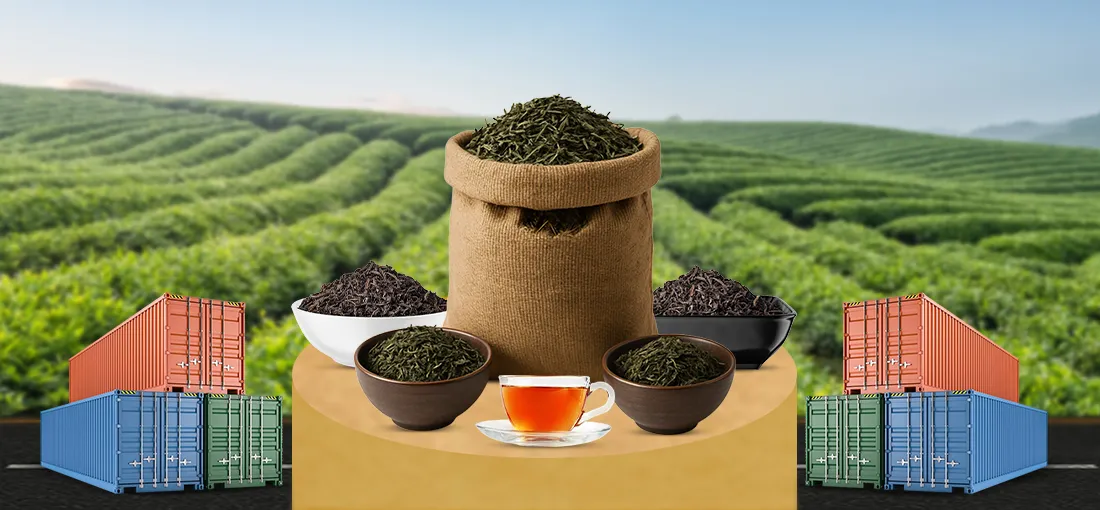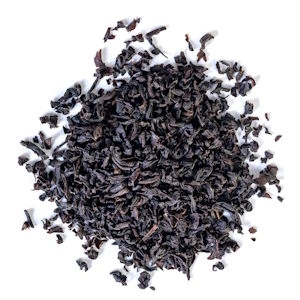
From Assam to Darjeeling, import an expansive assortment of Indian teas tailored to suit your market demand

Tea is one of the most inexpensive popular beverages that are consumed by all socio-economical consumers of the world. Out of the home market, the tea market is expanding globally. The global tea market is expected to witness a moderate growth rate in the next five years. From the year 2020 to 2027, the global tea market is expected to grow at a CAGR of 6.6%.
"Tea is the second most consumed beverage in the world after water. Tea is a refreshing aromatic beverage made by soaking the tea leaves in hot water."
All the Tea varieties, commonly known as “TEA”, are prepared from the leaves and leaf buds of Camellia Sinensis. Out of 4 varieties of Camellia Sinensis, C. sinensis var. sinensis, and C. s. var. assamica (JW Masters) Kitamura, are most commonly used to produce different types of tea varieties. The plant is native to the south, East, and Southeast Asia but is now cultivated across the globe. To refresh your morning, several tea varieties are available.
Welcome to Tradologie.com – The world’s 1st next-generation global B2b platform for branded food products and Agri-Commodities. Tradologie.com works as a B2B platform between 38,000+ verified exporters and 380,000+ genuine importers, where they can export and import all varieties of tea in bulk at the guaranteed best tea price in just a few steps. Let’s explore more !

It is stronger in flavor and is more oxidized than white, green, and oolong tea. The Black Tea is prepared when the tea leaves are fully crushed to enhance oxidation.
This tea is prepared either by CTC (Crush, Tea, Curl) or orthodox. The CTC method is used to produce the high-quality product from the medium or low-quality leaves while the orthodox method is done by either hand or by machines and is used to produce high-quality loose tea.
"Black Tea retains its flavor for several years and is a most common type of tea produced in the world"
Black tea is usually strong and alone tastes great or it can be mixed with milk, sugar, and other medicinal ingredients like ginger, elaichi, etc.
Green tea is produced from fresh tea leaves and does not go under oxidation. This tea is prepared by steaming and pan-frying the tea leaves and then dried. During the entire process, the “Polyphenols” molecule is maintained. This molecule is responsible for various benefits of Green Tea.
Some popular types of green tea are:
Green tea is most popular among Asians and is sometimes mixed with flavors of flowers, fruits, medicinal herbs to create flavored green tea.
Yellow tea is originated in China and has more health benefits than green tea. The name is attained due to its liquor-like color. The liquor-like bright yellow color is not natural and is obtained by the process called “Sealed Yellowing”.
Based on the area of tea plant plantation, yellow tea is broadly categorized into 3 main types, namely :
"Yellow tea is one of the rarest teas due to its expensiveness and highly sort after production"
This tea is partially oxidized tea. The oxidation level of this tea varies from 8% to 80% depending upon the level of oxidation.
Oolong Tea: withering -> cooling -> light rolling -> oxidizing -> roasting -> final rolling -> drying -> hand sorting.
Some of the popular types of Oolong Tea are:
"Taste of Oolong tea depends upon the type of Oolong tea used."
This tea is also known as dark tea or fermented tea as it has undergone microbial fermentation, from several months to years. Exposure to humidity, oxygen, and microflora in the oxygen alters the taste and smell of the tea. This tea is allowed for fermentation and then the process is stopped for some time and then again the fermentation process started.
India is the 4th largest exporter of Tea and is the 2nd largest tea producer in the world. Indian tea is one of the finest teas in the world due to strong geographical conditions, continuous innovation, and an augmented product mix. The tea is cultivated in 10 distinct regions of North-East and South Asia, namely :
Some of the most popular types of tea in India that are cultivated across the country for their immaculate taste and flavor are :
Connect with Us
We use cookies
We use cookies to enhance site functionality, improve user experience, analyze website performance, and deliver relevant content in accordance with our Cookie Policy.
We use cookies
Essential Cookies
Essential cookies are strictly necessary for Tradologie.com to operate properly. They enable core functionalities such as security, session management, network stability, and cookie consent preferences. These cookies do not collect personal data and cannot be disabled.
| Name | Vendor / Service | Purpose | Expiry | Privacy Policy |
|---|---|---|---|---|
| ASP.NET_SessionId | Tradologie.com / ASP.NET | Maintains secure user session across pages. | Session | https://privacy.microsoft.com/ |
| __RequestVerificationToken | Tradologie.com | CSRF protection for forms. | Session | https://www.tradologie.com/privacy-policy/ |
| cookie_consent | Tradologie.com | Stores consent preferences so the banner does not reappear. | 1 year | https://www.tradologie.com/privacy-policy/ |
| lang_pref | Tradologie.com | Stores preferred language. | 6 months | https://www.tradologie.com/privacy-policy/ |
| cf_clearance | Cloudflare | Confirms visitor passed bot checks; protects site. | 1 year | https://www.cloudflare.com/privacypolicy/ |
| __cf_bm | Cloudflare | Distinguishes bots from humans. | 30 minutes | https://www.cloudflare.com/privacypolicy/ |
Analytics Cookies
We use analytics cookies to gather anonymous, aggregated information about how visitors interact with Tradologie.com. This helps us improve the site, measure the success of content and services, and prioritize performance fixes.
| Name | Vendor / Service | Purpose | Expiry | Privacy Policy |
|---|---|---|---|---|
| _ga, _gid, _gat | Google Analytics (GA4) | Measure sessions, users, and pageviews. | 2 years / 24 hours / 1 minute | https://policies.google.com/privacy |
| _clck, _clsk | Microsoft Clarity | Records anonymized clicks, scrolls and sessions to improve UX. | 1 year / 1 day | https://privacy.microsoft.com/clarity |
| _pk_id.*, _pk_ses.* | Piwik PRO | Tracks sessions and returning users. | 13 months / 30 minutes | https://piwik.pro/privacy-policy/ |
| mf_user, mf_* | Mouseflow | Heatmaps and anonymous session replays for UX analysis. | 3 months / Session | https://mouseflow.com/privacy/ |
| stg_fired_* | CookieInformation / Tag Manager | Records tag firing events and campaign measurement. | Session | https://cookieinformation.com/privacy-policy/ |
| _clsk | Microsoft Clarity | Session aggregation for statistical reporting. | 1 day | https://privacy.microsoft.com/clarity |
| mf_user | Mouseflow | Aggregated session identifiers for reporting. | 3 months | https://mouseflow.com/privacy/ |
Functional Cookies
Functional cookies allow the website to provide enhanced usability and personalization. They store preferences such as language, region, chat settings, and login details for a smoother browsing experience. Disabling these cookies may limit certain features.
| Name | Vendor / Service | Purpose | Expiry | Privacy Policy |
|---|---|---|---|---|
| user_lang / lang | Tradologie.com | Remembers chosen language. | 1 year | https://www.tradologie.com/privacy-policy/ |
| timezone_pref | Tradologie.com | Stores timezone preference for display. | 6 months | https://www.tradologie.com/privacy-policy/ |
| remember_user | Tradologie.com | Keeps logged-in state when chosen. | 30 days | https://www.tradologie.com/privacy-policy/ |
| livechat_session | Tawk.to | Maintains chat session state. | Session | https://www.tawk.to/privacy-policy/ |
Marketing
Marketing cookies are used to deliver advertising that is relevant to you and to measure the effectiveness of our marketing campaigns across platforms such as Google, LinkedIn, Meta and Microsoft. These cookies are set only with your consent.
| Name | Vendor / Service | Purpose | Expiry | Privacy Policy |
|---|---|---|---|---|
| IDE, test_cookie | Google / DoubleClick | Ad delivery, frequency capping, remarketing. | 1 year | https://policies.google.com/technologies/ads |
| _gcl_au, _gcl_aw, _gcl_dc | Google Ads | Conversion tracking and ad click linking. | 3 months / 90 days | https://policies.google.com/privacy |
| 1P_JAR, NID, ANID, AEC | Personalization and ad preferences. | 30 days / 6 months / 13 months | https://policies.google.com/privacy | |
| YSC, VISITOR_INFO1_LIVE | YouTube (Google) | Tracks video engagement and ad metrics for embedded videos. | Session / 6 months | https://policies.google.com/privacy |
| _fbp, fr | Meta / Facebook Pixel | Targeting and conversion measurement for Facebook/Instagram ads. | 3 months | https://www.facebook.com/policy.php |
| li_gc | Stores cookie consent flag for LinkedIn services. | 6 months | https://www.linkedin.com/legal/privacy-policy | |
| li_sugr | LinkedIn Ads | Store cookie match of a user's identity for ads/retargeting. | 90 days | https://business.linkedin.com/marketing-solutions/ads |
| bcookie, lidc, UserMatchHistory, AnalyticsSyncHistory | LinkedIn Insight Tag | Advertising analytics, retargeting, and audience matching. | 1 month - 2 years | https://www.linkedin.com/legal/cookie-policy |
| _uetsid, _uetvid | Microsoft Ads (Bing) | Remarketing and ad performance tracking on Microsoft network. | 1 day / 13 months | https://privacy.microsoft.com/advertising |